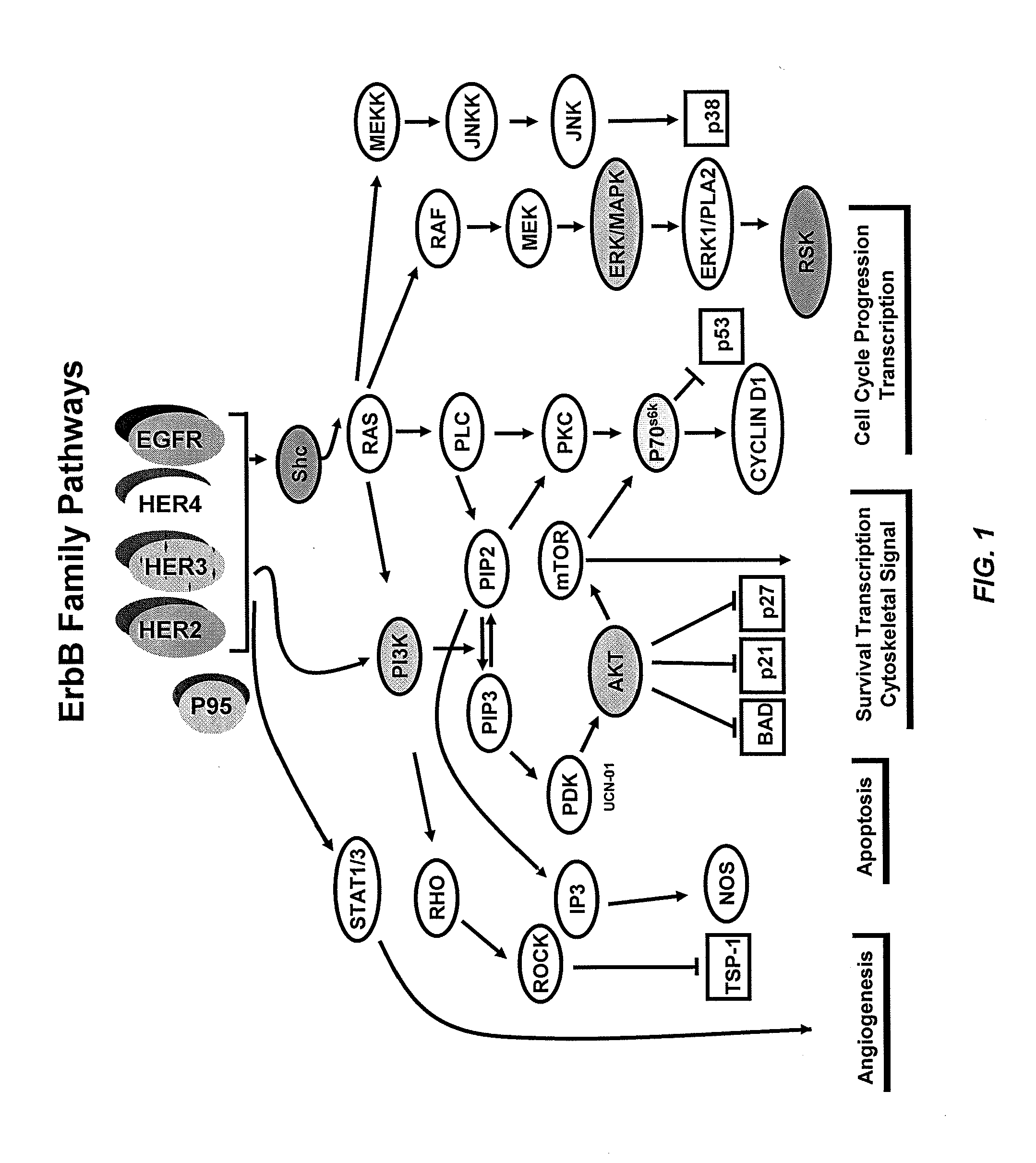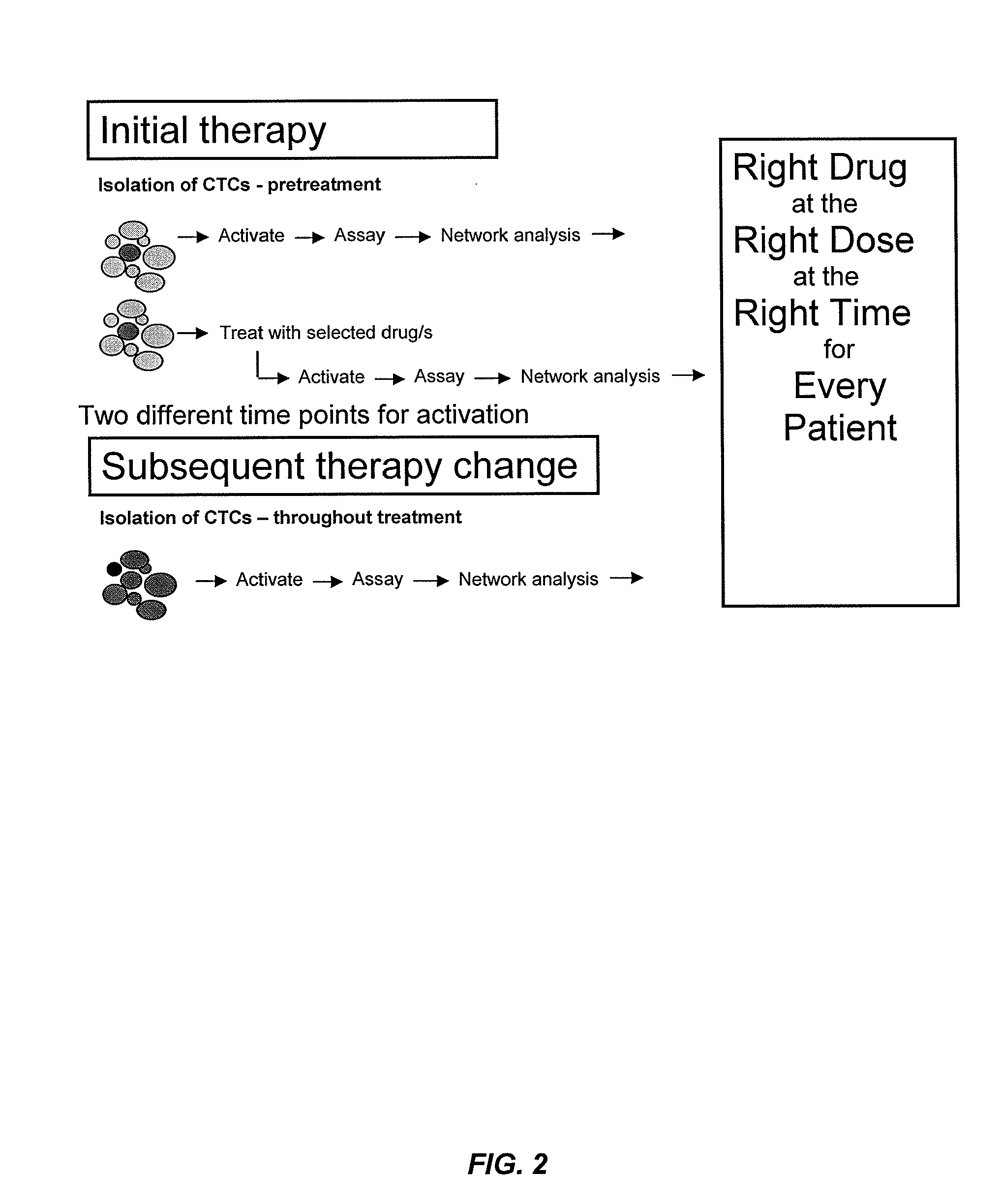Drug selection for cancer therapy by profiling signal transduction proteins in ascites or pleural efflux samples
a signal transduction protein and ascites technology, applied in the field of drug selection for cancer therapy by profiling signal transduction proteins in ascites or pleural efflux samples, can solve the problems of poor overall survival and general poor prognosis, and achieve the effect of improving the likelihood prediction of lung cancer subjects
- Summary
- Abstract
- Description
- Claims
- Application Information
AI Technical Summary
Benefits of technology
Problems solved by technology
Method used
Image
Examples
example 1
Stimulation and Lysis of Cancer Cells from Ascites and Pleural Efflux
[0584]In particular embodiments, cancer cells that are present in ascites and pleural efflux samples can be isolated using techniques known those skilled in the art. Preferably, cancer cells are isolated and / or purified from ascites and pleural efflux using anti-EpCAM antibodies (commercially available from companies such as, e.g., Abcam, Inc. (Cambridge, Mass.), clone 323 / A3 (catalog number ab85987); BD Biosciences (San Diego, Calif.), clone EBA-1 (catalog number 347200); and Santa Cruz Biotechnology, Inc. (Santa Cruz, Calif.); clone C-10 (catalog number sc-25308)).
Cell Stimulation and Lysis of Isolated Cancer Cells from Ascites and Pleural Efflux:
[0585]Cell stimulation:[0586]1) Growth factors EGF, Hrg, HGF, and / or IGF (e.g., all at 100 nM) are added to the cells and incubated at 37° C. for 5 minutes.
[0587]Cell stimulation with drug treatment (steps can be performed in any order):[0588]1) Sample is incubated with ...
example 2
Single Detection Microarray ELISA with Tyramide Signal Amplification
[0599]This example illustrates a multiplex, high-throughput, single detection microarray ELISA having superior dynamic range that is suitable for analyzing the expression level or activation status of signal transduction molecules in cells such as cancer cells:[0600]1) Capture antibody was printed on a 16-pad FAST slide (Whatman Inc.; Florham Park, N.J.) with a 2-fold serial dilution.[0601]2) After drying overnight, the slide was blocked with Whatman blocking buffer.[0602]3) 80 μl of cell lysate was added onto each pad with a 10-fold serial dilution. The slide was incubated for two hours at room temperature.[0603]4) After six washes with TBS-Tween, 80 μl of biotin-labeled detection antibody (e.g., a monoclonal antibody recognizing phosphorylated c-Met or a monoclonal antibody recognizing c-Met regardless of activation state) was incubated for two hours at room temperature.[0604]5) After six washes, streptavidin-labe...
example 3
Proximity Dual Detection Microarray ELISA with Tyramide Signal Amplification
[0607]This example illustrates a multiplex, high-throughput, proximity dual detection microarray ELISA having superior dynamic range (e.g., CEER, also referred to herein as COPIA) that is suitable for analyzing the expression level or activation status of signal transduction molecules in cells such as cancer cells:[0608]1) Capture antibody was printed on a 16-pad FAST slide (Whatman Inc.) with a serial dilution ranging from 1 mg / ml to 0.004 mg / ml.[0609]2) After drying overnight, the slide was blocked with Whatman blocking buffer.[0610]3) 80 μl of A431 cell lysate was added onto each pad with a 10-fold serial dilution. The slide was incubated for two hours at room temperature.[0611]4) After six washes with TBS-Tween, 80 μl of detection antibodies for the proximity assay diluted in TBS-Tween / 2% BSA / 1% FBS was added to the slides. The incubation was for 2 hours at room temperature.[0612]a) As a non-limiting exa...
PUM
| Property | Measurement | Unit |
|---|---|---|
| concentrations | aaaaa | aaaaa |
| concentrations | aaaaa | aaaaa |
| concentrations | aaaaa | aaaaa |
Abstract
Description
Claims
Application Information
 Login to View More
Login to View More - R&D
- Intellectual Property
- Life Sciences
- Materials
- Tech Scout
- Unparalleled Data Quality
- Higher Quality Content
- 60% Fewer Hallucinations
Browse by: Latest US Patents, China's latest patents, Technical Efficacy Thesaurus, Application Domain, Technology Topic, Popular Technical Reports.
© 2025 PatSnap. All rights reserved.Legal|Privacy policy|Modern Slavery Act Transparency Statement|Sitemap|About US| Contact US: help@patsnap.com



